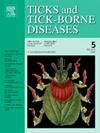Detection of multiple novel viruses in argasid and ixodid ticks in Mexico
IF 3.4
2区 医学
Q2 INFECTIOUS DISEASES
引用次数: 0
Abstract
We examined ticks from Mexico using viral metagenomics to increase our understanding of the composition and diversity of the tick virome. The analysis was performed using 3,127 ticks of four Ixodidae spp. and one Argasidae spp. collected in 2019 to 2021 from domestic animals in four states of Mexico (Chiapas, Chihuahua, Guerrero, and Michoacán). All ticks were homogenized and tested for viruses using two approaches. In the first approach, an aliquot of each homogenate underwent two blind passages in Ixodes scapularis (ISE6) cells. Supernatants from all second passage cultures were subjected to polyethylene glycol (PEG) precipitation to enrich for virions then RNAs were extracted from the precipitates and analyzed by unbiased high-throughput sequencing (UHTS). In the second approach, an aliquot of every homogenate was subjected to PEG precipitation then RNAs were extracted and analyzed by UHTS, allowing for the detection of viruses unable to replicate in ISE6 cells. We identified seven novel species of viruses from multiple taxonomic groups (Bunyavirales, Flaviviridae, Nodaviridae, Nyamivirdae, Rhabdoviridae, Solemoviridae, and Totiviridae), some of which are highly divergent from all classified viruses and cannot be assigned to any established genus. Twelve recognized species of viruses were also identified. In summary, multiple novel and recognized viruses were detected in ticks from Mexico, highlighting the remarkable diversity of the tick virome.
墨西哥蜱虫和粘虫中多种新型病毒的检测
我们使用病毒宏基因组学检查了来自墨西哥的蜱虫,以增加我们对蜱虫病毒的组成和多样性的理解。分析使用了2019年至2021年从墨西哥四个州(恰帕斯州、奇瓦瓦州、格雷罗州和Michoacán)的家畜中收集的4种伊蚊科和1种剑虫科的3127只蜱。所有蜱均质化并使用两种方法检测病毒。在第一种方法中,每个匀浆的等分在肩胛骨(ISE6)细胞中进行两次盲传代。所有二代培养的上清液经聚乙二醇(PEG)沉淀以富集病毒粒子,然后从沉淀中提取rna并进行无偏高通量测序(UHTS)分析。在第二种方法中,将每个匀浆的等分物进行PEG沉淀,然后提取rna并用UHTS进行分析,允许检测无法在ISE6细胞中复制的病毒。我们从多个分类群(Bunyavirales,黄病毒科,noddaviridae, Nyamivirdae, Rhabdoviridae, Solemoviridae和Totiviridae)中鉴定出7种新的病毒,其中一些与所有已分类的病毒高度不同,不能归属于任何已建立的属。还鉴定了12种已确认的病毒。总之,在墨西哥蜱虫中检测到多种新的和已知的病毒,突出了蜱虫病毒的显著多样性。
本文章由计算机程序翻译,如有差异,请以英文原文为准。
求助全文
约1分钟内获得全文
求助全文
来源期刊

Ticks and Tick-borne Diseases
INFECTIOUS DISEASES-MICROBIOLOGY
CiteScore
6.90
自引率
12.50%
发文量
185
审稿时长
6-12 weeks
期刊介绍:
Ticks and Tick-borne Diseases is an international, peer-reviewed scientific journal. It publishes original research papers, short communications, state-of-the-art mini-reviews, letters to the editor, clinical-case studies, announcements of pertinent international meetings, and editorials.
The journal covers a broad spectrum and brings together various disciplines, for example, zoology, microbiology, molecular biology, genetics, mathematical modelling, veterinary and human medicine. Multidisciplinary approaches and the use of conventional and novel methods/methodologies (in the field and in the laboratory) are crucial for deeper understanding of the natural processes and human behaviour/activities that result in human or animal diseases and in economic effects of ticks and tick-borne pathogens. Such understanding is essential for management of tick populations and tick-borne diseases in an effective and environmentally acceptable manner.
 求助内容:
求助内容: 应助结果提醒方式:
应助结果提醒方式:


